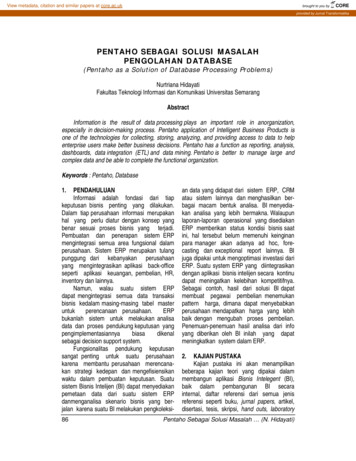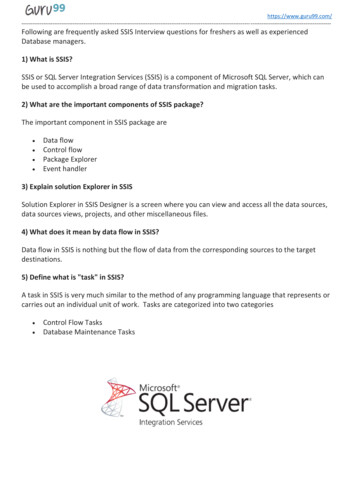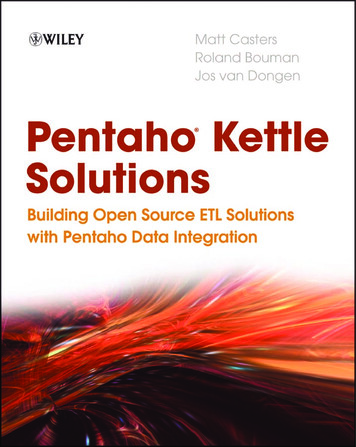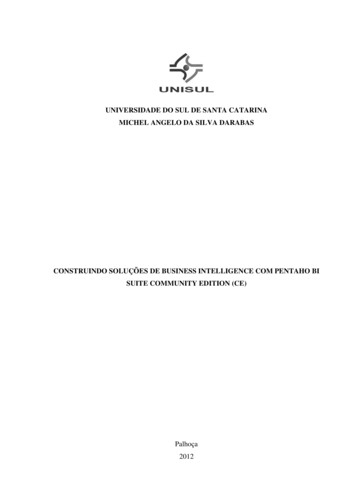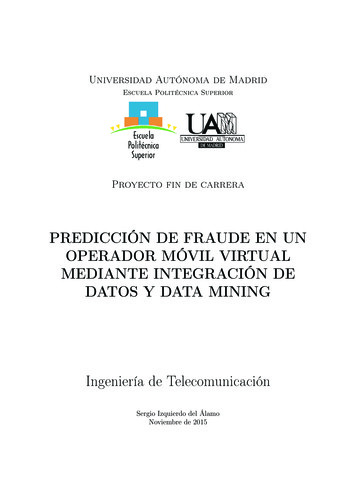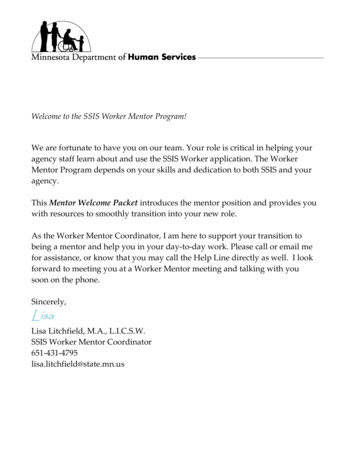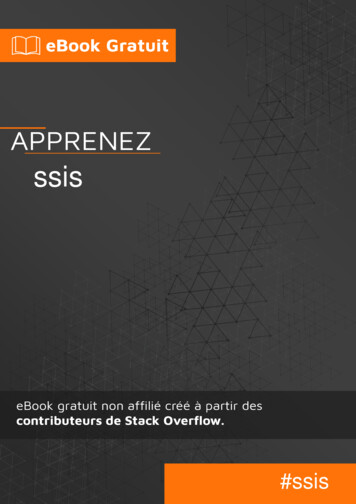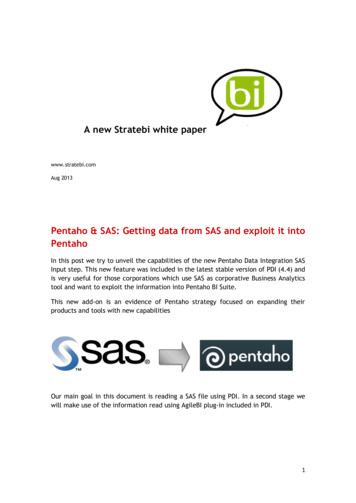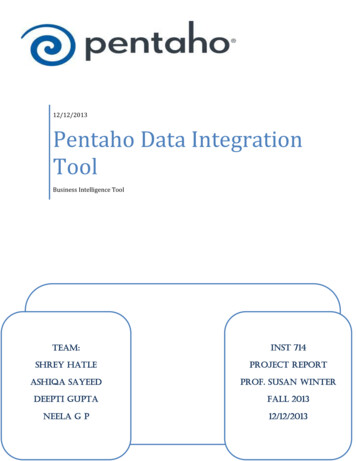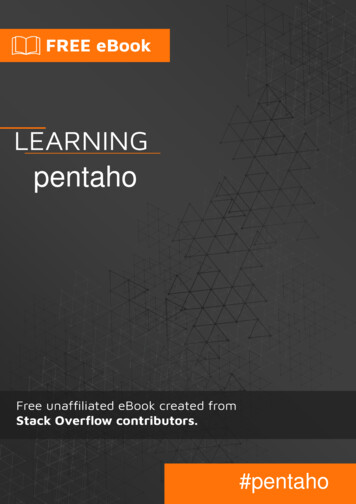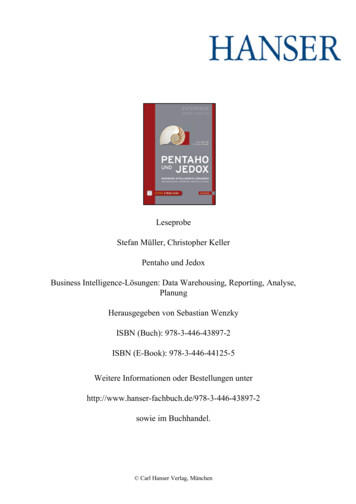
Transcription
Microsoft SSIS and Pentaho Kettle:A Comparative Study for Three-Tier Data WarehousesMichael L GrecolGeorgia Southern University
Grecol Page 2ContentsIntroduction . 3Microsoft SSIS . 3SSIS Development Interface and Capabilities . 3Pentaho Kettle . 6Kettle Development Interface and Capabilities . 6A Taxonomy of ETL Activities by Tool. 9ETL Processes . 10Extraction Phase. 11Data Cleansing Phase . 11Transformation Phase . 12Loading Phase . 12Use in a 3-tier Data Warehouse . 13Summary . 14Microsoft SSIS and Pentaho Kettle: A Comparative Study
Grecol Page 3IntroductionExtraction, Transformation, and Loading (ETL) tools integrate heterogeneous schemata,extracting, transforming, cleansing, validating, filtering and loading data from sources into a datawarehouse[1]. The ETL process and the associated tools may be used in a greatly varied numberof situations where data must be cleaned and moved between data sources. The subject of ETLtools is too broad for a whitepaper; therefore, this whitepaper will only cover the use of two ETLtools (Microsoft SSIS and Pentaho Kettle) within the purview of data warehouse design andimplementation.Microsoft SSISMicrosoft provides a proprietary ETL tool named SQL Server Integration Services(SSIS). SSIS is packaged with Microsoft SQL Server and requires a SQL Server License to useit. Microsoft also offers a full business intelligence suite. Additionally, SSIS may be used with anumber of database servers through OLE and ADO.NET drivers[2]. Microsoft does not offer thesource code as part of the product meaning the developer cannot make modifications to theproduct to suit the project needs. Also, there is no avenue for a developer to contribute to thefuture version of the product other than requesting the functionality to Microsoft.SSIS Development Interface and CapabilitiesMicrosoft’s SSIS system includes three components,1. Business Intelligence Development Studio (BIDS) seen in Figure 12. Data profile Viewer3. Package Execution UtilitySince most of the development efforts take place in BIDS, the remainder of this paperdiscusses its capabilities. BIDS is based on Microsoft’s Visual Studio IDE. BIDS has a robustMicrosoft SSIS and Pentaho Kettle: A Comparative Study
Grecol Page 4drag and drop interfaces and emphasizes configuration over coding. Microsoft documentationclaims that you can make robust ETL processes without coding [3]; however, the environmentdoes provide for a script component which allows for scripting in Visual Basic or Visual C#.Figure 1: SSIS BIDS Screenshot.A BIDS project includes data sources, data source views and SSIS packages. Themajority of design effort will be spent in the SSIS package area. Each package is comprised ofControl Flows, Data Flows and Event Handlers. There are three different types of Control Flowsnamely:1. Containers: provide the structure2. Tasks: provide functionalityMicrosoft SSIS and Pentaho Kettle: A Comparative Study
Grecol Page 53. Precedence constraints: provides connections to and from tasks and containers into anordered flow.An example of use of different control flows is in Figure 2. Control Flows allow forexecution of various tasks such as SQL, VB, VC# scripting as well as FTP, Send Mail and WebService Tasks. A total of 28 Control Flow items are available for use. Control Flows may callData Flows or other Control Flows. The relationship between Data Flows and Control Flows canbe seen in Figure 3.The Data Flows are actual data transformations. Data Flows are divided into Sources,Transformations and Destinations. The Source Data Flows provide components to access a datasource using ADO.net, Excel, Flat File, OLE DB, Raw File and XML sources. Data FlowTransformations have 29 transformation tasks to choose from including Fuzzy Lookups, Fuzzygrouping, slowly changing dimensions along with several aggregate functions. SSIStransformation objects are very configurable and favor chaining function calls for stringmanipulations[3].SSIS includes robust Event Handlers which can assign any combination of Control Flowtasks for every object in the SSIS project. Twelve events are available for each object such asonPreExecute, onPostExecute and onError [3].Figure 2: Example Control Flow Tasks.Figure 3:SSIS Control and Data Flow Tasks.Microsoft SSIS and Pentaho Kettle: A Comparative Study
Grecol Page 6Pentaho KettlePentaho Kettle is an open-source data integration solution. It comes in two versions, TheCommunity Edition, licensed as under the GNU public license and The Enterprise Editionlicensed under a commercial license. Pentaho’s development community consists of around8,000 members[4]. Pentaho offers a complete business intelligence suite including dataintegration, data discovery and exploration and data mining. It connects to any database whichcan be accessed through a JDBC driver. In addition, Pentaho supports Apache Hadoop andprovides an interface into SAP. Since Pentaho source code is available, the program can bemodified to meet the needs of the project. Also, the developers can take part in the Pentahodeveloper community to contribute towards future versions of the product[5].Kettle Development Interface and CapabilitiesPentaho Kettle is comprised of four separate programs.1. Spoon: Pentaho’s development environment which is used to design and codetransformation jobs.2. Pan: for running transformation XML files created by Spoon or from a databaserepository.3. Kitchen: Kitchen is for running transformation XML files created by Spoon or from adatabase repository which are scheduled to run in batch mode.4. Carte: Carte is a web-server which allows execution of transformations remotely.Because the majority of development effort will take place in the Spoon program, theremainder of this paper will deal with its capabilities. Pentaho’s development user interface(Spoon) is based on the Java-based Eclipse IDE as seen in Figure 4. The tool is organized underthree viewing perspectives:Microsoft SSIS and Pentaho Kettle: A Comparative Study
Grecol Page 7 Data integration: Allows for design of ETL processes and jobs through drag and drop,configuration and scripting. Model: Allows for designing OLAP metadata models Visualize: Allows for testing of OLAP metadata modelsSpoon uses a drag and drop interface with a long list of built-in functions. In Spoon adata integration job consists of a Job and Transformation designs. A conceptual model ofSpoon’s job structure can be seen in Figure 5. Spoon’s job scripting capabilities are robust andinclude three scripting options: JavaScript, Shell and SQL Scripting. Additionally, nine filetransfer functions are available including FTP, SFTP, and SSH. Spoon’s transformationcomponents are very specific and include: 38 data input source types including common text fileformats, office applications, database tables and a direct interface to SAP as well as otherapplications, 26 individual transformations and 15 Lookup methods including file systemoperations, database queries and web service calls. String manipulations are simple and to thepoint favoring regular expressions for validation and transformation. Transformations includeseven scripting options such as SQL, JavaScript and Java classes. Spoon also allows thedeveloper to develop or use existing plugins to add functionality[5].Microsoft SSIS and Pentaho Kettle: A Comparative Study
Grecol Page 8Figure 4: Screenshot of Spoon.Figure 5: Spoon’s job conceptual model.Microsoft SSIS and Pentaho Kettle: A Comparative Study
Grecol Page 9A Taxonomy of ETL Activities by ToolBelow is a table showing the built-in transformations provided by both tools. The table conceptwas provided by [6].ClassTransformationSQL SSISPentaho KettleCategory1:1Row-Level:- Character Map- Add ChecksumFunction that can - Copy Column- Add Constantsbe applied locally - Data Conversion- Add Sequenceto a single row.- Derived Column- Add Value fields changing sequence- Script Component- Add XML- OLE DB Command- Calculator- Cache Transform- Number Range- Slowly Changing- Replace in StringDimensions- Select Values- Other Filters (not null,- Set field Value to a constantselections, etc)- Split Fields- String Operations- Strings Cut- Value Mapper- If field Value is null- Null if.- ETL Metadata injection- Filter Rows, Last Row, Java Filter,Regex Evaluation- Scripting, Java, JavaScript, SQL.N:1Unary Grouper:Transform a setof rows to asingle row.- Aggregate- Pivot- Row Flattener- Unique Rows- Unique Rows (HashSet)- Analytic Query- Group by- Memory Group by- Univariate Statistics1:NUnary Splitter:Split a single rowto a set of rows.-Unpivot-Fuzzy Grouping-Row Normaliser- Split Fields to Rows- Clone RowN:MUnary Holistic:- SortPerform a- Percentage Samplingtransformation to - Row Samplingthe entiredataset(blocking).Microsoft SSIS and Pentaho Kettle: A Comparative Study- Sort Rows- XSL Transformation- Change file encoding- Sample Rows
Grecol Page 10Binary or N-ary:Combine manyinputs into oneoutput.Union Like- Union All- MergeJoin-like- Merge Join- Lookup- Import Column- Fuzzy Lookup- Term Extraction- Term LookupJoin-like- Get ID from Slave Server- Row Denormaliser- Set Field Value- Append streams- Database Join- Database Lookup- HTTP Post, client, REST, Stream,SOAP Lookup.- Sorted Merge- Merge Join- Merge Rows (diff)Union Like- Join RowsRouters: Locallydecide for eachrow, which of themany outputs itshould be sent to.- Conditional Split- Multicast- Process Files- Switch/Case- Dynamic SQL Row- Mapping (input, output, subtransformation)Table 1: Taxonomy of ETL activities by tool [3, 5, 6].ETL ProcessesThe ETL process takes place when the data warehouse is first populated and during everyupdate cycle[1]. Being an important part of a data warehouse project it is typical thatimplementing the ETL process may be the task consuming the greatest effort[7]. The ETLprocess is defined as incorporating the following steps [1, 8, 9]:1. The Extraction Phase: extraction of information.2. The cleansing Phase: scrubbing of the subject dataset.3. The Transformation Phase: transforming data to the format of the data warehouse.4. The Loading Phase: data is loaded into the data warehouse.There are a large number of ETL tools available which can execute these tasks. There isno set standard regarding how to develop the above steps; therefore, each tool has its own set ofMicrosoft SSIS and Pentaho Kettle: A Comparative Study
Grecol Page 11methods, languages rules and limitations to achieve the same goal. This complicates the selectionof an ETL tool as it is difficult to do apples to apples comparisons. This paper compares twoproducts which are very much are opposites in terms of development philosophy, Pentaho Kettleand Microsoft SSIS and compares their capabilities to perform each phase of the ETL process.Extraction PhaseThe Extraction Phase centers around the tools ability to retrieve relevant data fromheterogeneous sources[1]. SSIS offers options to extract raw files, flat files, XML files, Excel aswell as ADO.net and OLE DB sources. It’s 1:1, Binary and N-ary transformation tools aresufficient to extract the needed data. Each tool offers ample configuration abilities. The eventhandlers give the developer a strong tool to control the flow of SSIS packages. Pentaho Kettleoffers a longer list of available tools. Kettle’s tools are designed for more specific purposes;therefore, easier to use. However, Kettle does not offer the robust event model that SSIS does.On the other hand, Kettle offers many more data source type options than SSIS includinginterfaces to Apache Hadoop, SAP and Google Analytics as well as decryption options. Lastly,Kettle offers the flexibility of Shell scripting and JavaScript to increase its overall capabilities.Data Cleansing PhaseThe Data Cleansing Phase is crucial to the data warehouse system because it improvesthe data quality[1]. SSIS offers lookup features such as OLE lookup and fuzzy lookup whichcan help improve data quality. However the pre-made tools fall short for complex data cleansing.As in The Extraction Phase, SSIS’s event model offers the developer an added layer of controland execution options. Kettle offers much more cleansing options with the ability to lookupusing values using more types of web services and file types. Additionally, Kettle’s use ofRegex, Custom Java Classes and JavaScript offer the developer simple but powerful tools tovalidate and cleanse data. Microsoft’s claims of code-free ETL design may be overstated; toMicrosoft SSIS and Pentaho Kettle: A Comparative Study
Grecol Page 12achieve complex data cleansing code will have to be written in C# or if data is appropriatelystaged in SQL Server, T-SQL.Transformation PhaseThe Transformation Phase converts data from the operational source format to the datawarehouse format[1]. Golfarelli and Rizzi define main transformation processes as conversionand normalization along with matching and selection operations[1]. SSIS offers processes totransform data into destination formats using transform and lookup functions. Character andmath functions are provided through chaining standard functions. Basic lookups are provided aswell as cache transform and deriving columns. Kettle’s offers many more transformation andlookup functions than SSIS. Each Kettle function is designed for a specific use case. Kettleoffers a large array of row-level functions and unary groupers which are well suited to thetransformation phase of the ETL process. Additionally, powerful JavaScript, user-defined Javaclasses and custom plug-ins increase its flexibility. If the developer needs functionality whichdoesn’t exist in the program the source code is available and can be modified to suit the needs ofan enterprise.Loading PhaseThe Loading Phase is the last step in the ETL process and consists of two methods, eitherrefresh or update[1]. SSIS is well suited to load into many types of databases through itsADO.net and OLE DB objects. Additionally, it has a dimension processing object which allowthe developer to define the refresh or update methods. Additionally, SSIS offers a partitionprocessing object which works in conjunction with SQL Server’s Analysis Services partitions.SSIS offers very limited output file types. Kettle allows loading through any database which hasa JDBC driver. Additionally, Kettle offers a number of output types to be used in The LoadingPhase including XML, SQL file output, Access and Excel. In addition, Kettle offers bulk loadingMicrosoft SSIS and Pentaho Kettle: A Comparative Study
Grecol Page 13for many databases such as MySQL, MS SQL and Terradata and others. Kettle also has aninterface to Apache Hadoop built in which adds distributive processing capabilities[10].Use in a 3-tier Data WarehouseThe chief difference in a three-tier data warehouse is that reconciled operational data isstored in its own database layer[1]. This condition produces new challenges to data warehousedesigners and the ETL tools they use. Namely, the transformation layer outputs directly to thereconciled data layer[1]. Additionally, The Loading Phase will be more complex as thereconciled layer and the data marts may be located on different servers. Due to these factors, arobust ETL tool must be used. SSIS is suitable for such use; however a code-free design isunlikely with the complexities that will be encountered. SSIS has a limited number oftransformation and loading objects which means a less clean design as developers are forced toget more functionality out of limited tools. SSIS has advanced partitioning features but arelimited to SQL Server Analysis Services installations.Pentaho Kettle is very well suited to the complexities of the three-tier data warehouse.Due to the large number of specialized transformation objects, the resulting design will be moreelegant and maintainable. Kettle has bulk load options for several popular databases allowing theenterprise to choose the database that fits the needs of the data warehouse. Additionally, withbuilt-in Hadoop functionality, developers can manage ETL processes across clusters of serverswhich leads to more options in the overall data warehouse design.Microsoft SSIS and Pentaho Kettle: A Comparative Study
Grecol Page 14SummaryBoth SSIS and Kettle are robust solutions to perform ETL in a three-tier data warehouse.SSIS emphasizes configuration over coding; however, because of limited amount oftransformation objects available, coding will be required to process complex data. SSIS’sstrength comes from its control flow, data flow and event driven architecture. It allows greatflexibility to the developer to design the structure and flow the ETL process. Because of limitedsupport for non-Microsoft databases, SSIS is more suitable for the enterprise whichpredominately uses Microsoft SQL Server and has T-SQL, C# experts on staff.Pentaho Kettle offers more transformation objects which are more straightforward. Itincludes many more options to access outside data such as an SAP interface, Google Analyticsand several options to access web services. It can be used on either Windows or Linux operatingsystems. Kettle’s strength comes from the ability to use shell scripting, JavaScript, user-definedJava classes, custom programmed plug-ins and the ability to modify source code to meet theneeds of the project. Loading is efficient with many bulk loading options for major databaseservers. Additionally, having Hadoop functionality built in increases the ability of the developerto employ clusters of servers performing parallel processing.Microsoft SSIS and Pentaho Kettle: A Comparative Study
Grecol Page 15References[1]M. Golfarelli and S. Rizzi, Data Warehouse Design, Modern Principles andMethodologies: McGraw Hill Companies, srl Publishing Group Italia, 2009.[2]R. Parida and C. Sabotta. (2012, 07/05/12). SSIS and Data Sources. [3](2012, 07/05/12). SQL Server Integration Services. ms141026.aspx[4]J. Foley. (2008, Startup Of The Week: Pentaho Offers Opens Source BI Alternative.InformationWeek. Available: 012, 07/05/2012). Pentaho, Powerful Analytics Made Easy. Available:http://www.pentaho.com/[6]P. Vassiliadis, A. Simitsis, and E. Baikousi, "A taxonomy of ETL activities," presented atthe Proceedings of the ACM twelfth international workshop on Data warehousing andOLAP, Hong Kong, China, 2009.[7]T. A. Majchrzak, T. Jansen, and H. Kuchen, "Efficiency evaluation of open source ETLtools," presented at the Proceedings of the 2011 ACM Symposium on AppliedComputing, TaiChung, Taiwan, 2011.[8]S. Alkis, "Optimizing ETL Processes in Data Warehouses," 2005, pp. 564-575.[9](2012, 06/25/12). ETL Enterprise Data Integration, ETL Tools [Website]. Available:www.etltools.net[10](2012, 07/07/12). Welcome to Apache Hadoop . oft SSIS and Pentaho Kettle: A Comparative Study
Microsoft SSIS and Pentaho Kettle: A Comparative Study Pentaho Kettle Pentaho Kettle is an open-source data integration solution. It comes in two versions, The Community Edition, licensed as under the GNU public license and The Enterprise Edition licensed under a commercial license. Pentaho's development community consists of around
